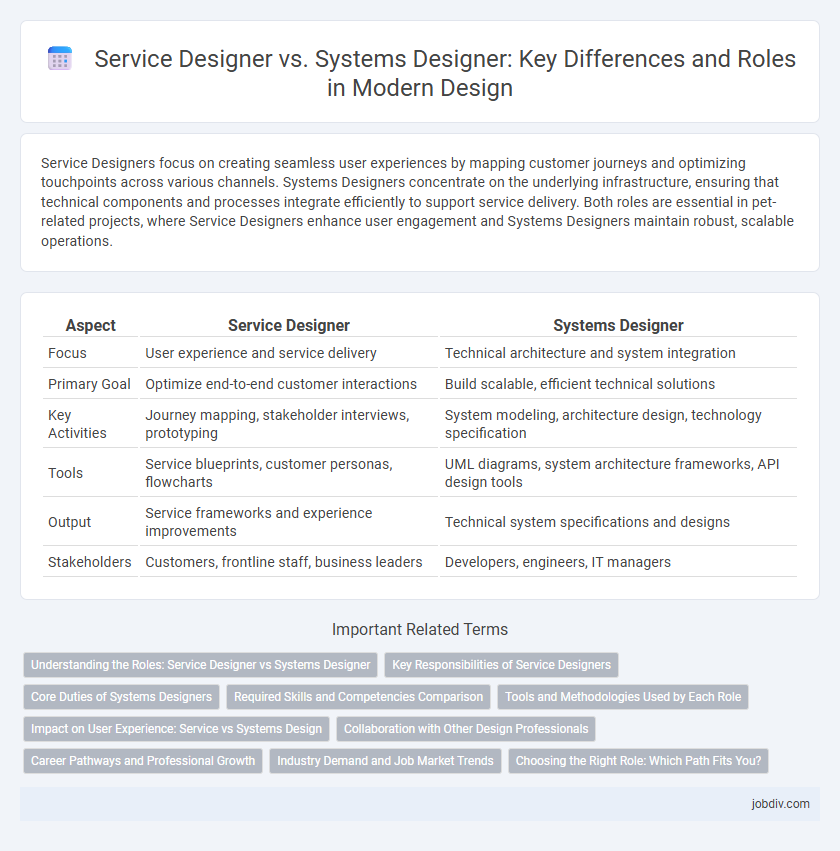Service Designers focus on creating seamless user experiences by mapping customer journeys and optimizing touchpoints across various channels. Systems Designers concentrate on the underlying infrastructure, ensuring that technical components and processes integrate efficiently to support service delivery. Both roles are essential in pet-related projects, where Service Designers enhance user engagement and Systems Designers maintain robust, scalable operations.
Table of Comparison
| Aspect | Service Designer | Systems Designer |
|---|---|---|
| Focus | User experience and service delivery | Technical architecture and system integration |
| Primary Goal | Optimize end-to-end customer interactions | Build scalable, efficient technical solutions |
| Key Activities | Journey mapping, stakeholder interviews, prototyping | System modeling, architecture design, technology specification |
| Tools | Service blueprints, customer personas, flowcharts | UML diagrams, system architecture frameworks, API design tools |
| Output | Service frameworks and experience improvements | Technical system specifications and designs |
| Stakeholders | Customers, frontline staff, business leaders | Developers, engineers, IT managers |
Understanding the Roles: Service Designer vs Systems Designer
Service Designers focus on crafting user-centric experiences by mapping customer journeys, identifying pain points, and designing seamless service interactions across touchpoints. Systems Designers concentrate on structuring complex technical or organizational systems, ensuring components work cohesively to achieve functional performance and scalability. Both roles require collaboration but prioritize different aspects: human experience for Service Designers and system architecture for Systems Designers.
Key Responsibilities of Service Designers
Service Designers primarily focus on creating seamless customer experiences by mapping user journeys and identifying touchpoints across service ecosystems. They analyze customer needs, coordinate cross-functional teams, and prototype service interactions to enhance satisfaction and operational efficiency. Their key responsibility involves aligning service delivery with user expectations and business goals through iterative design processes.
Core Duties of Systems Designers
Systems Designers primarily focus on creating and integrating complex systems to ensure seamless functionality across multiple components and platforms. They analyze user requirements, technical constraints, and system architecture to develop scalable solutions that optimize performance and maintainability. Their core duties include system modeling, specification development, and collaboration with engineers to align technical implementation with overall business objectives.
Required Skills and Competencies Comparison
Service Designers excel in user experience research, journey mapping, and stakeholder collaboration, emphasizing empathy and communication skills to create seamless service interactions. Systems Designers require strong analytical skills, systems thinking, and proficiency in modeling complex system architectures, ensuring integration and functionality across technical components. Both roles demand problem-solving abilities and a deep understanding of design methodologies, but Service Designers prioritize human-centered approaches while Systems Designers focus on technical coherence and scalability.
Tools and Methodologies Used by Each Role
Service designers primarily use customer journey mapping, service blueprints, and personas to create seamless user experiences, leveraging tools like Miro, Smaply, and UXPressia for visualization and collaboration. Systems designers focus on system architecture modeling, UML diagrams, and integration frameworks, utilizing software such as Enterprise Architect, IBM Rational, and ArchiMate to ensure robust and scalable system solutions. Both roles apply iterative design thinking and agile methodologies to align their outputs with business goals and user needs.
Impact on User Experience: Service vs Systems Design
Service designers enhance user experience by mapping customer journeys and optimizing touchpoints to ensure seamless interactions, directly addressing user needs and emotions. Systems designers focus on structuring complex technical and organizational frameworks, enabling efficient backend processes that indirectly improve user experience through system reliability and integration. Both roles complement each other, with service design emphasizing user-centric solutions and systems design ensuring the robustness and scalability of those solutions.
Collaboration with Other Design Professionals
Service Designers collaborate closely with UX designers, researchers, and stakeholders to create seamless user experiences that integrate both frontstage and backstage processes. Systems Designers work alongside software engineers, architects, and data analysts to develop scalable, interconnected systems that support complex organizational workflows. Both roles require effective communication and interdisciplinary teamwork to align design solutions with business goals and technical constraints.
Career Pathways and Professional Growth
Service Designers focus on improving customer interactions and journey mapping, developing skills in user experience, customer research, and service blueprinting that open career pathways in UX research, product management, and innovation strategy. Systems Designers specialize in analyzing and optimizing complex systems through systems thinking, modeling, and architecture, leading to roles in systems engineering, enterprise architecture, and operations management. Both career paths demand continuous learning in technology and human-centered design principles, fostering professional growth through certifications, cross-disciplinary collaboration, and strategic problem-solving capabilities.
Industry Demand and Job Market Trends
Service designers are increasingly sought after in industries prioritizing customer experience and digital transformation, with job growth projected at 16% over the next decade according to the U.S. Bureau of Labor Statistics. Systems designers remain critical in sectors like manufacturing and IT infrastructure, where demand for complex system optimization continues to rise by about 12% annually. Emerging trends indicate service design roles are expanding in tech startups and healthcare, while systems design expertise is essential for integrating AI and IoT technologies across enterprise environments.
Choosing the Right Role: Which Path Fits You?
Service Designers prioritize user experience by mapping customer journeys and optimizing touchpoints, focusing on human-centered solutions that enhance interactions across services. Systems Designers concentrate on complex architecture, integrating components and processes within organizational or technological frameworks to ensure systemic efficiency and scalability. Choosing the right role depends on your interest in either empathetic, user-focused problem solving or holistic, structural system optimization.
Service Designer vs Systems Designer Infographic

 jobdiv.com
jobdiv.com